Lladro is celebrated worldwide for its exquisite porcelain artistry, renowned for delicate craftsmanship and timeless, ethereal designs. Its success has also shone a spotlight on Spain’s rich ceramic tradition, inspiring other talented makers to create stunning alternatives with their own unique flair. Lladró controls about 70% of the Valencian porcelain market!
The Story of Lladro
Founded in 1953 by three brothers—Juan, José, and Vicente Lladro—in the small town of Almàssera, Valencia, Lladro began as a small studio crafting plates and vases. By the 1960s, the brothers pivoted to figurines, gaining international acclaim for their romantic, dreamlike creations.

Lladro’s distinctive style blends classical influences with contemporary techniques, often portraying serene figures, animals, or romanticized everyday moments. Notable milestones include:
- 1970: The company opened its “City of Porcelain,” a sprawling headquarters and production site near Tavernes Blanques, Valencia.
- 1985: Introduction of the limited-edition series, making some pieces highly collectible.
- Present Day: Still in operation, Lladro remains a global leader in porcelain art, diversifying into lighting, jewelry, and home décor.
Did You Know?
- Each Lladro figurine is hand-finished, and larger pieces can take weeks to produce.
- The company has a second line called Nao, which features simpler, more affordable designs aimed at younger collectors.
- Lladro creates figurines in both glazed and matte finishes. While the glazed finish gives their sculptures a glossy, polished look, the matte finish offers a more subtle, soft texture, adding a unique charm to each piece. Here’s an example in our marketplace of a Lladro porcelain figurine with a matte finish. And another example of a Lladro with a glazed finish.
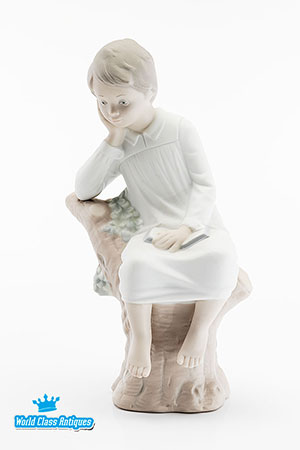
Spanish Alternatives to Lladro
Spain’s history of fine ceramics birthed several companies inspired by Lladro’s success. While some created their own unique styles, others leaned heavily into producing pieces that could easily be mistaken for Lladro. So why exactly are Lladro porcelain figurines so widely imitated?
Lladro porcelain figurines are imitated because of their distinctive style, which combines artistic elegance, technical mastery, and emotional resonance. Here’s what makes Lladro so compelling—and why competitors often try to emulate them:
- Lladro figurines are instantly recognizable for their Soft pastel colors – Their muted tones convey serenity and refinement.
- They portray dreamlike themes such as romantic scenes, graceful ballerinas, tender moments of family life, and depictions of innocence have universal appeal.
- Lladro showcases exquisite detailing, including delicate features, flowing garments, and lifelike expressions that demonstrate unmatched craftsmanship.
- Lladro’s roots in Valencia, a region with a rich ceramic tradition, inspired other local artisans and companies to follow its lead. Proximity to the same skilled workforce and materials gave rise to competitors like Tengra and Miquel Requena, who naturally adopted similar styles.
Let’s explore some of the well-known porcelain companies that adopted comparable designs.
Nao by Lladro
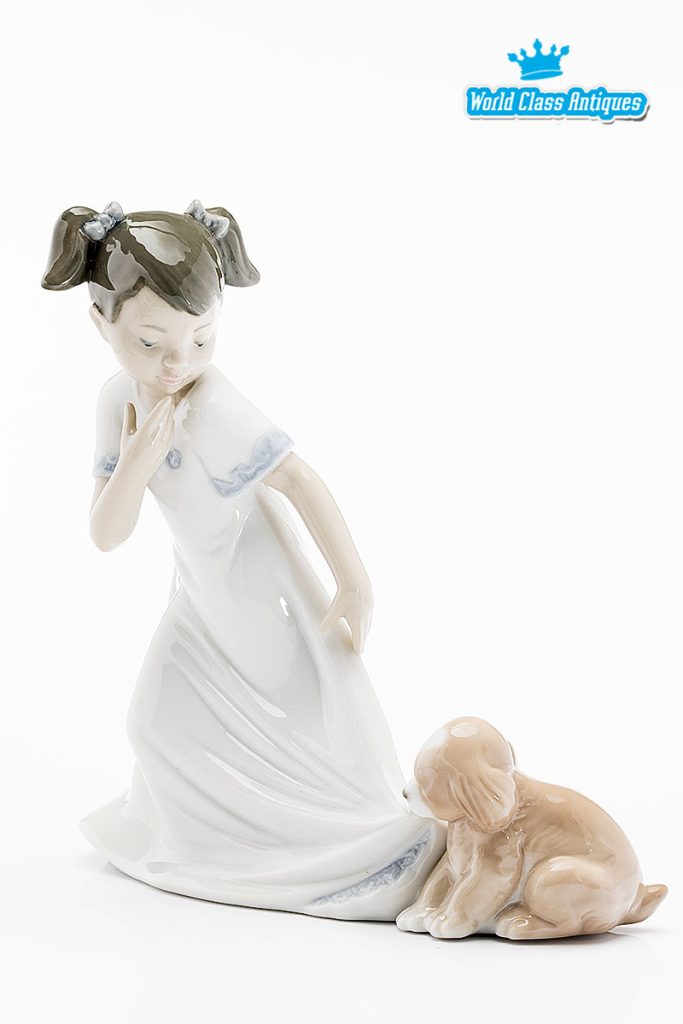
Years Active: 1968 – Present. The Lladró family acquired the Nao porcelain line in 1968.
Although technically a Lladro brand, Nao deserves its own mention. Designed to be more accessible, Nao pieces are made in a similar style but lack the complexity and detail of the main Lladro line. They’re a perfect introduction for new collectors.
The name Nao comes from old sailing boats from the time of Columbus, and symbolizes creativity, skill, and magic. NAO figurines are clearly marked on the base for easy identification. Here’s an example in our marketplace of a Nao porcelain figurine.
Tengra
Years Active: 1964 – 1990s, no longer in operation
Founded in Valencia, Tengra began as a competitor to Lladro, offering porcelain figurines at a more affordable price point. Their designs often mirrored Lladro’s soft, pastel hues and serene expressions, making them popular among collectors on a budget.
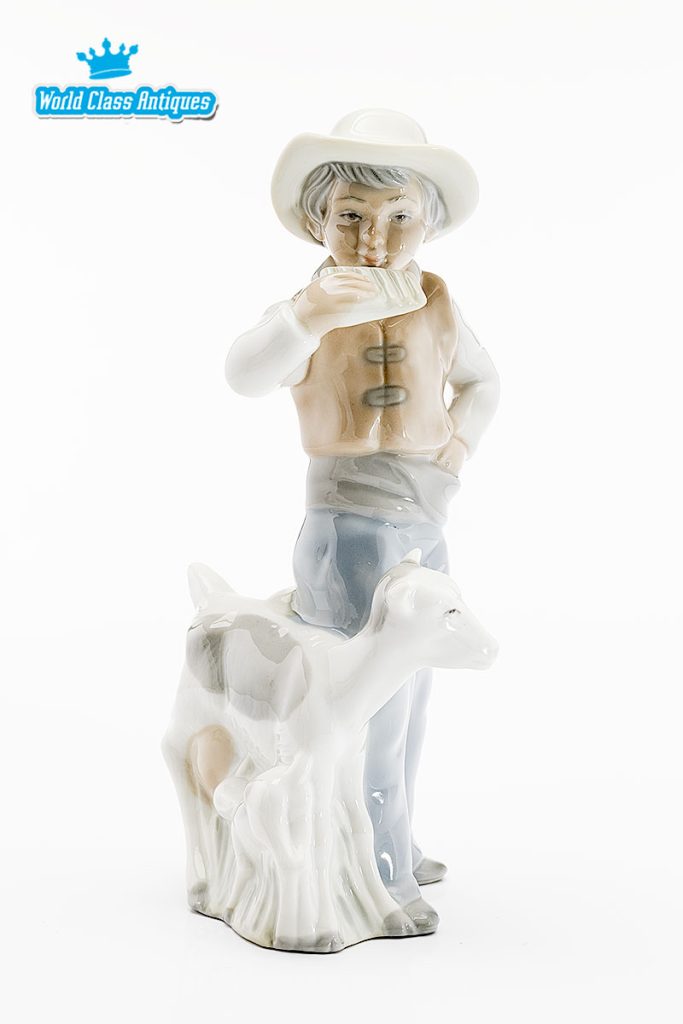
Tengra’s figurines tend to have slightly less refined details but are cherished for their charm and artistry. While the company ceased production in the early 2000s, Tengra figurines remain sought-after, especially older models.
Did You Know?
- Tengra pieces were largely hand-painted, with subtle variations that make each one unique.
- Some early Tengra models were unmarked, leading to frequent misattributions to Lladro.
- We have an example in our marketplace that is clearly marked on the base as Tengra – Hand Made in Spain Valencia.
Porcelanas Miquel Requena
Years Active: 1950s – Present (as Miquel Requena Ceramics)
Another Valencia-based brand, Porcelanas Miquel Requena has long been a producer of porcelain art. Their figurines often feature traditional Spanish themes, such as dancers, flamenco performers, and rural life.

While less “dreamy” than Lladro’s style, Miquel Requena’s pieces stand out for their bold use of color and dynamic poses. They remain in production today, though their focus has shifted to decorative items like vases and tiles.
Did You Know?
- Miquel Requena was one of the first Spanish porcelain makers to experiment with matte glazes, a departure from Lladro’s signature glossy finish.
Vicente Martinez Porcelain
Years Active: 1950s – Early 1990s, no longer in operation
Vicente Martinez was another Valencia-based company known for its figurines. Their designs were clearly inspired by Lladro, featuring soft colors and delicate features. However, their production quality was inconsistent, with some pieces rivaling Lladro’s finesse while others fell short.
The company shuttered in the 1990s, but collectors continue to seek out its more refined works.
Did You Know?
- Many Vicente Martinez figurines were exported to the U.S., often sold in department stores as budget-friendly alternatives to Lladro.
Nadal
Years Active: 1915 – Present
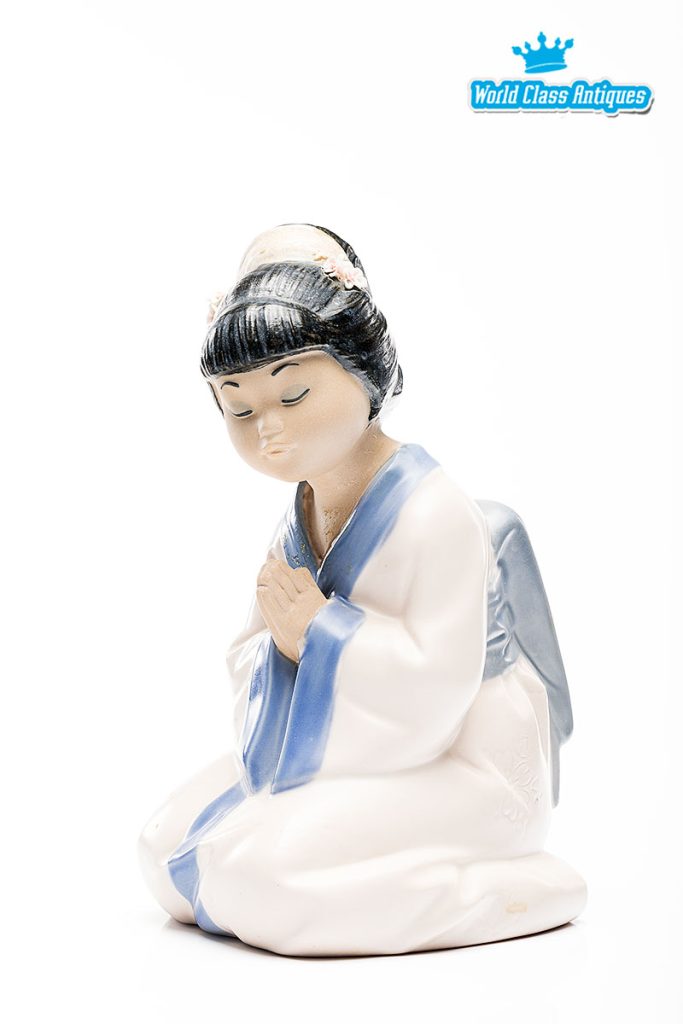
Nadal is another one of the Spanish companies known for producing figurines similar to Lladro. Based in Valencia, Spain—just like Lladro—Nadal became notable for its porcelain figurines that closely resembled Lladro’s style. The company’s designs often feature serene themes, pastel tones, and delicate detailing, making them popular among collectors seeking an alternative to Lladro. We currently have a scarce listing of a Nadal Geisha entertainer available for sale, as showcased in this section.
A Brief History of Nadal
- Founded: 1915 by Enrique Nadal in Valencia, Spain.
- Focus: Nadal initially specialized in ceramic tableware and home decor. In the 20th century, the company shifted to producing porcelain figurines.
- Lladro Influence: By the 1970s, Nadal began creating figurines clearly inspired by Lladro, featuring the same graceful and romantic aesthetic.
- Present Day: Nadal is still in operation, though its figurines are less prominent in international markets compared to Lladro.
Did You Know?
- Nadal’s figurines often focus on family, motherhood, and religious themes, with a particular emphasis on the nativity scene.
- Some Nadal pieces are marked with “Nadal Spain” or “Nadal Porcelain,” making them easier to distinguish from Lladro.
- Unlike Lladro, Nadal also produced figurines with more modern and minimalist styles, catering to changing trends in home decor.
Nalda Porcelain or NaLda (as per their logo)
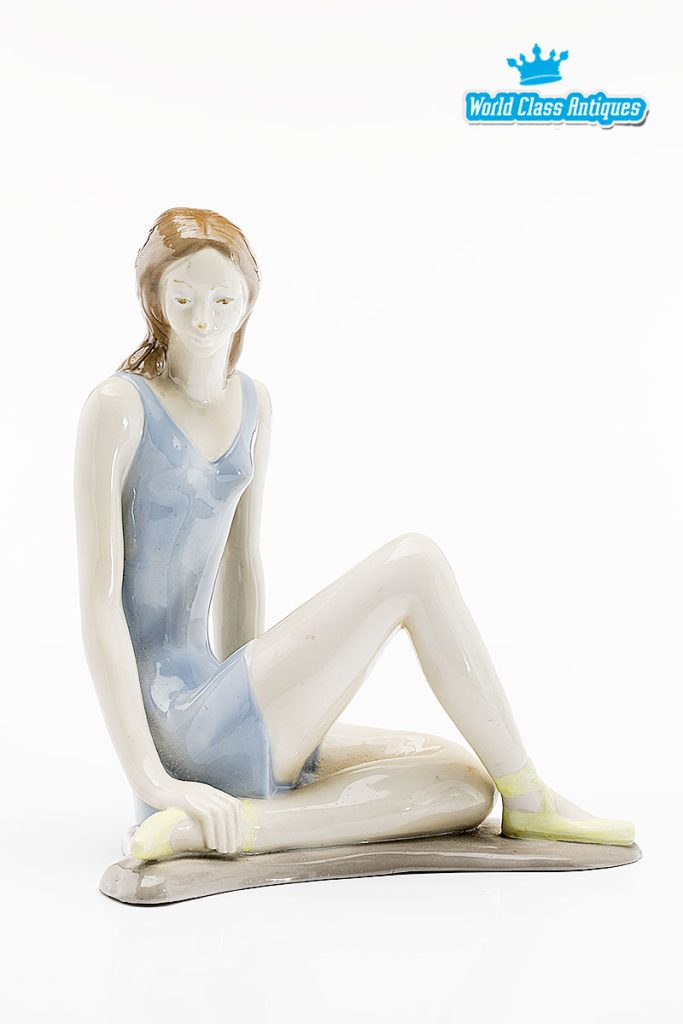
A lesser-known Spanish porcelain brand, not to be confused with the similar-sounding “Nadal”. Nalda was active in producing decorative figurines between the late 1940s and 1971. It is particularly notable for its connection to the early careers of the Lladró brothers, who worked for Nalda before establishing their own iconic porcelain brand. These pieces are rare on the secondary market and may share stylistic similarities with early Lladró designs. Unfortunately we couldn’t find more information about this company. If you know more about it, please leave a comment. You can also read a bit more about it here.
That said, we do have one available – a scarce Nalda porcelain figurine. Like the other pieces mentioned here, it embodies the hallmark Lladro style, featuring soft pastel hues and elegant detailing. At the time of writing this post, we couldn’t find a similar one.
Rex Valencia (Porcelanas Rex S.L.)
Years Active: 1970s – 1990s, no longer in operation.
Another Spanish porcelain firm we will be discussing is Rex Valencia, sometimes compared to Lladro because of its similar method of figure manufacturing. Porcelanas Rex was inspired by the fame and worldwide appeal of Lladro’s delicate and romantic designs, same with Nadal, Tengra, and other Valencia-based manufacturers.
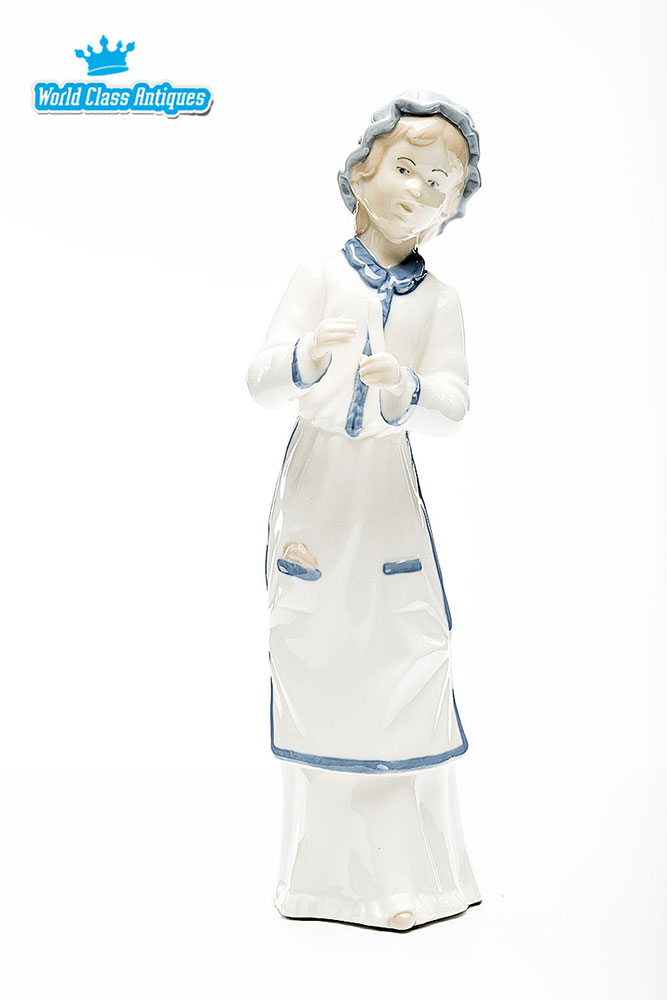
A Brief History of Rex Valencia
- Founded: The exact founding year of Rex Valencia is less well-documented, but it emerged during the mid-20th century, likely in the 1960s or 1970s, as a competitor to Lladro.
- Location: Based in Valencia, Spain, the heart of Spain’s porcelain production.
- Focus: Rex Valencia produced figurines that mirrored Lladro’s signature soft colors, glossy finishes, and themes of elegance, family life, and traditional Spanish culture.
- Closure: The company ceased operations sometime in the late 20th century, making its figurines increasingly collectible.
Did You Know?
- Rex Valencia’s figurines were hand-painted, but the detailing was often less refined than Lladro’s. This slight difference can help collectors distinguish between the two brands.
- Many Rex Valencia pieces feature themes that overlap with Lladro, such as women in flowing dresses, children at play, and pastoral scenes.
- Rex Valencia figurines are usually marked with the words “Rex” or “Rex Valencia”, often in a cursive or stamped style.
Lesser-Known Makers – TITO
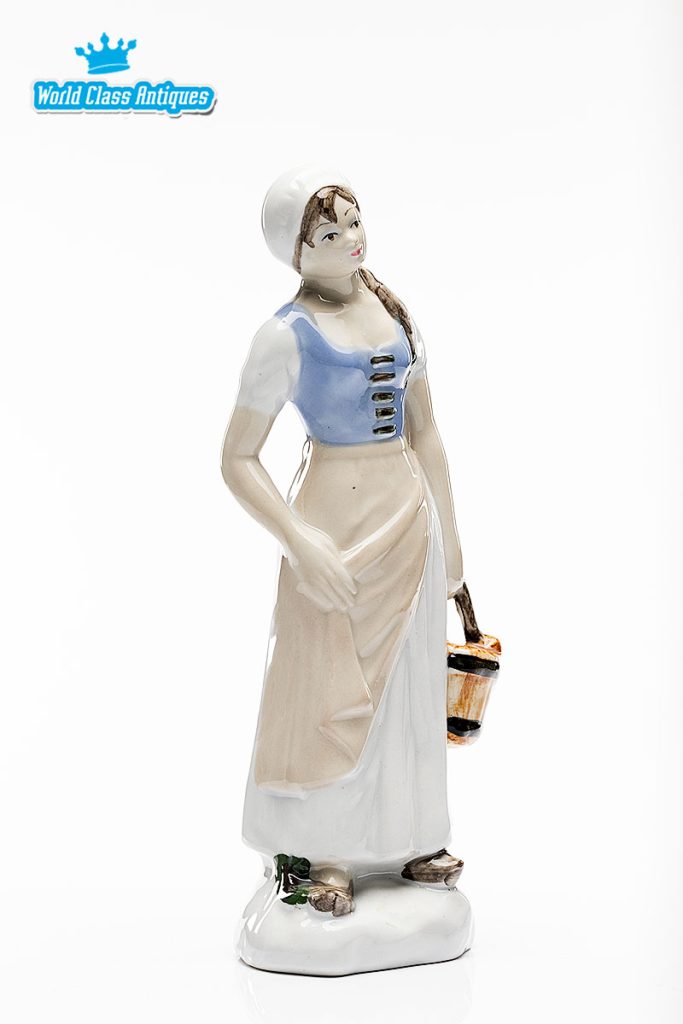
Over the years, we’ve observed a variety of porcelain figurines crafted in the Lladro style. Some were unmarked, or simply labelled with Made in Spain, or even Valencia, Made in Spain. The Lladro style has undoubtedly influenced numerous artists in the realm of porcelain, serving as a source of inspiration and imitation.
The stamp on this figurine – Farm Girl With Bucket features the TITO stamp along with Made in Spain below it. The origin of this mark remains uncertain, and it may or may not be linked to the esteemed TITO pottery family from Úbeda, Spain. Alternatively, is there another Valencia-based company that has ventured into Lladro-style porcelain figurines? Most likely! See more photographs of the TITO Farm Girl With Bucket.
The pottery currently available in the marketplace, along with the marks attributed to Paco Tito from Úbeda, suggests that it likely was not crafted by him. We would greatly appreciate any additional information you might have about this porcelain maker.
Discover Spanish Porcelain Treasures in Lladro Style
Explore our marketplace for exquisite Spanish porcelain figurines, including sought-after Lladro pieces and beautiful look-alikes from brands like Rex Valencia, Nadal, and Tengra.





